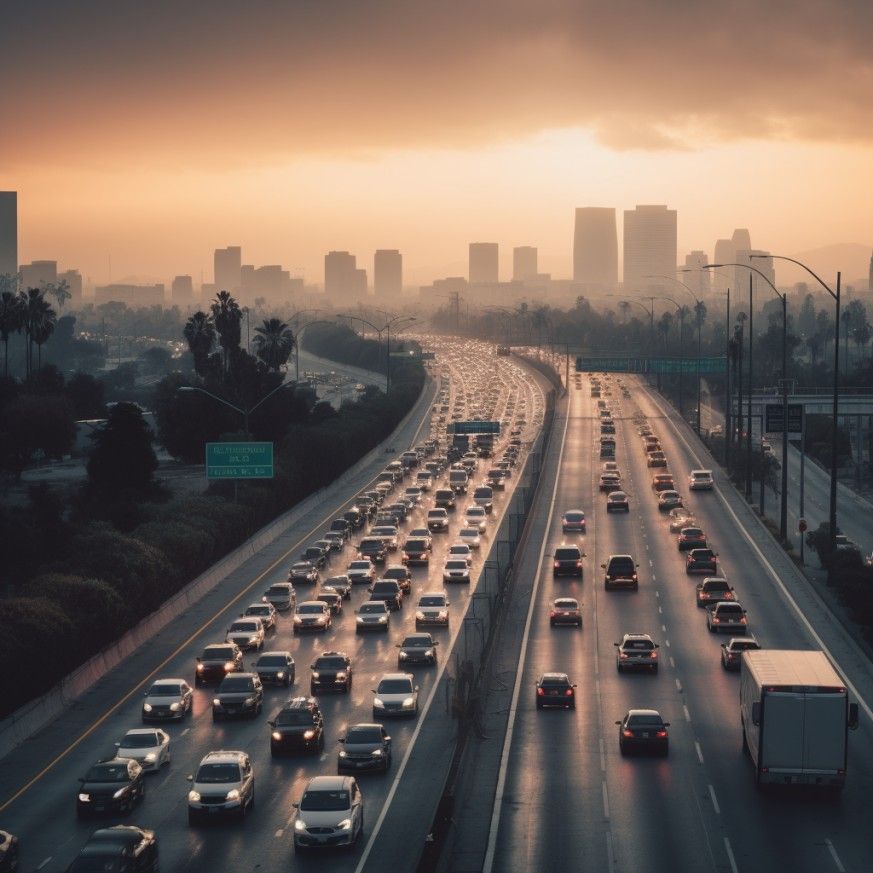Table of Contents
Southern California’s picturesque landscapes and bustling cities are interconnected by an extensive web of roadways. However, beneath this scenic facade lies a sobering reality: certain roads in this region are notorious for their high rates of accidents, injuries, and fatalities. Understanding which roads pose the most significant risks can empower drivers to exercise increased caution and advocate for necessary safety improvements.
The most dangerous roads in Southern California are determined based on a combination of factors, including the frequency of traffic accidents, the severity of injuries sustained, and the number of fatalities recorded over a specific period. Additional considerations include road design flaws, traffic volume, and environmental conditions contributing to hazardous driving.
What Is the Most Dangerous Road in California?
While several highways in California have garnered attention for their perilous conditions, Interstate 5 (I-5) holds the grim distinction of being California’s deadliest road, with a total of 128 deaths reported in 2022 alone.
The Top 10 Most Dangerous Southern California Roadways
Interstate 5
Stretching from the Mexican border through California, I-5 is one of the state’s busiest highways. The segment known as “The Grapevine,” a 40-mile stretch near Tejon Pass, is particularly hazardous due to steep grades, ice, sharp curves, and extreme weather conditions like snowstorms and wildfires. These factors contribute to frequent closures and accidents.
Interstate 10
Connecting Santa Monica to the Arizona border, I-10 traverses densely populated areas with heavy traffic volumes. The freeway’s intersections with major routes in Los Angeles County have been sites of numerous accidents, often attributed to heavy traffic.
Interstate 15
As a significant corridor between Southern California and Las Vegas, I-15 sees many travelers. The stretch through San Bernardino County, especially near the Cajon Pass, is notorious for accidents due to steep inclines, heavy truck traffic, and adverse weather conditions.
US 101
Running along the California coast, US-101 is scenic and perilous. It ranks as the second most dangerous road in California and the 16th most dangerous in America. Sections in Los Angeles County, mainly through urban areas, experience frequent accidents due to congestion and complex interchanges.
Highway 99
Over its entire North to South route, SR-99 has the highest fatality rate among California highways, with 445 deaths recorded between 2018 and 2022. The highway’s design, with numerous at-grade crossings and varying lane widths, contributes to its dangers.
Sierra Highway
This historic route runs parallel to modern freeways. It has winding and narrow sections, including a three-and-a-half-mile segment in Canyon County that records 2.85 fatalities per mile.
State Route 126
Connecting Ventura to Santa Clarita, SR-126 has been dubbed “Blood Alley” due to its high rate of fatal head-on collisions. Despite improvements, the highway continues to see serious crashes, often attributed to challenging road conditions.
Highway 1
While offering breathtaking ocean views, Highway 1 is known for its sharp turns, narrow lanes, and landslide susceptibility. The stretch just east of Carbon Canyon Road in Malibu, known as “Dead Man’s Curve,” has been the site of 52 fatalities between 2013 and 2023, highlighting the road’s inherent dangers.
Interstate 405
Known for its heavy congestion, I-405 is a major artery through Los Angeles. The high traffic volume, frequent lane changes, and occasional aggressive driving behaviors contribute to its high accident rate.
State Route 138
Dubbed “Death Trap Highway,” SR-138 east of Palmdale has a history of fatal accidents. Despite safety improvements, challenges like sharp curves and high speeds persist, making it a road warranting caution.
Dangerous Roadways in Los Angeles County
Beyond the major highways, several local roads in Los Angeles County have been identified as particularly hazardous, with multiple accidents occurring daily.
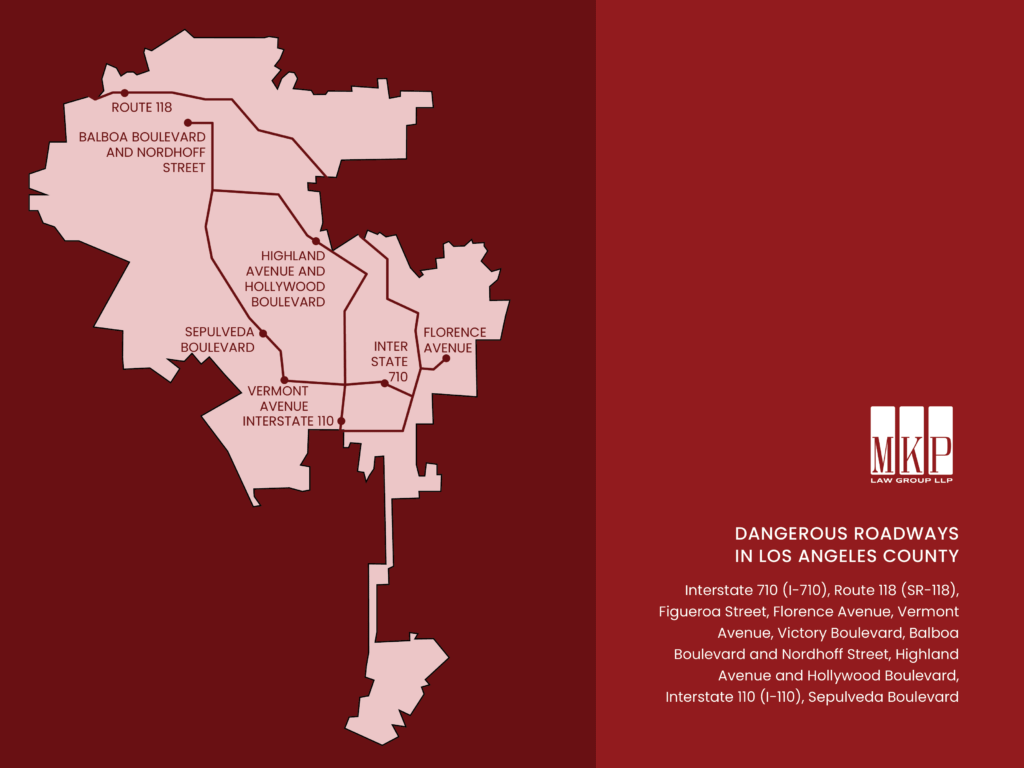
Dangerous roads in Los Angeles County include:
- Interstate 710 (I-710): As a freight corridor, I-710 experiences heavy truck traffic, leading to frequent accidents and congestion.
- Route 118 (SR-118): This freeway has sections with sharp curves and heavy traffic, contributing to a higher incidence of accidents.
- Devonshire Street and Reseda Boulevard: The intersection of these two major streets has been the site of numerous collisions, often due to high traffic volumes, signal timing issues, and people driving over the speed limit.
- Figueroa Street: Running through densely populated areas, Figueroa Street has a high rate of pedestrian and vehicle accidents. Between 2009 and 2019, there were 29 collisions with either fatal or severe injuries.
- Florence Avenue: This significant east-west corridor experiences frequent accidents, particularly at intersections lacking adequate traffic controls.
- Route 74 (Ortega Highway): Known for its winding path through the Santa Ana Mountains, Route 74 is popular among motorcyclists. Still, it is also notorious for fatal accidents due to sharp turns and steep drop-offs.
- Vermont Avenue: As one of the longest north-south streets in Los Angeles, Vermont Avenue sees many accidents, especially in areas with heavy pedestrian traffic.
- Victory Boulevard: Spanning multiple neighborhoods, Victory Boulevard is frequently congested, leading to numerous rear-end collisions and pedestrian accidents.
- Balboa Boulevard and Nordhoff Street: This intersection has been identified as a high-risk area due to heavy traffic flow and a busy intersection in a congested commercial area, increasing the likelihood of accidents.
- Highland Avenue and Hollywood Boulevard: As a major tourist destination, this intersection sees high vehicle and pedestrian traffic volumes, making it a hotspot for collisions and one of the most dangerous intersections for pedestrians in Los Angeles.
- Interstate 110 (I-110): Also known as the Harbor Freeway, I-110 experiences heavy congestion, sudden lane changes, and frequent traffic incidents.
- Manchester Avenue at Avalon Boulevard & Normandie Avenue: These intersections in South Los Angeles report high accident rates, particularly involving pedestrians and cyclists.
- Sepulveda Boulevard: Running parallel to the 405 Freeway, Sepulveda Boulevard is a heavily traveled route with frequent collisions due to congestion and aggressive driving.
Dangerous Roads in Orange County
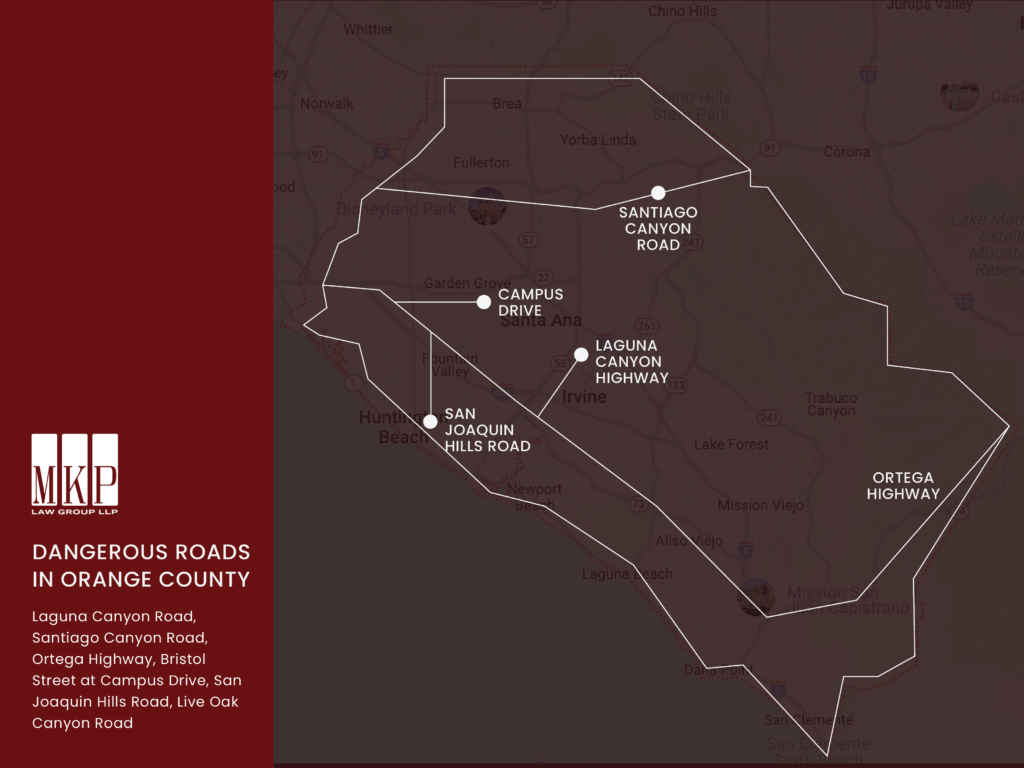
Dangerous roads in Orange County include:
- Laguna Canyon Road (State Route 133): Known for its winding path through Laguna Beach, this road has a history of serious accidents due to sharp curves and limited visibility.
- Santiago Canyon Road: Often called the “Road of Death,” this stretch between Jamboree Road and Chapman Avenue is infamous for high-speed crashes and poor lighting.
- Ortega Highway (State Route 74): This scenic yet treacherous road is perilous for motorcyclists due to blind turns and steep drop-offs.
- Bristol Street at Campus Drive, Newport Beach: A busy intersection in Orange County with many collisions, often due to high speeds, failing to yield at red lights, and distracted driving.
- MacArthur Boulevard at San Joaquin Hills Road: This major thoroughfare is known for frequent vehicle and pedestrian accidents. High speed contributes to the number of accidents in this area.
- Live Oak Canyon Road (County Route 19): A winding road with limited guardrails and high speeds, making it particularly hazardous for inexperienced drivers and drivers unfamiliar with its terrain.
Dangerous Roads in San Bernardino County
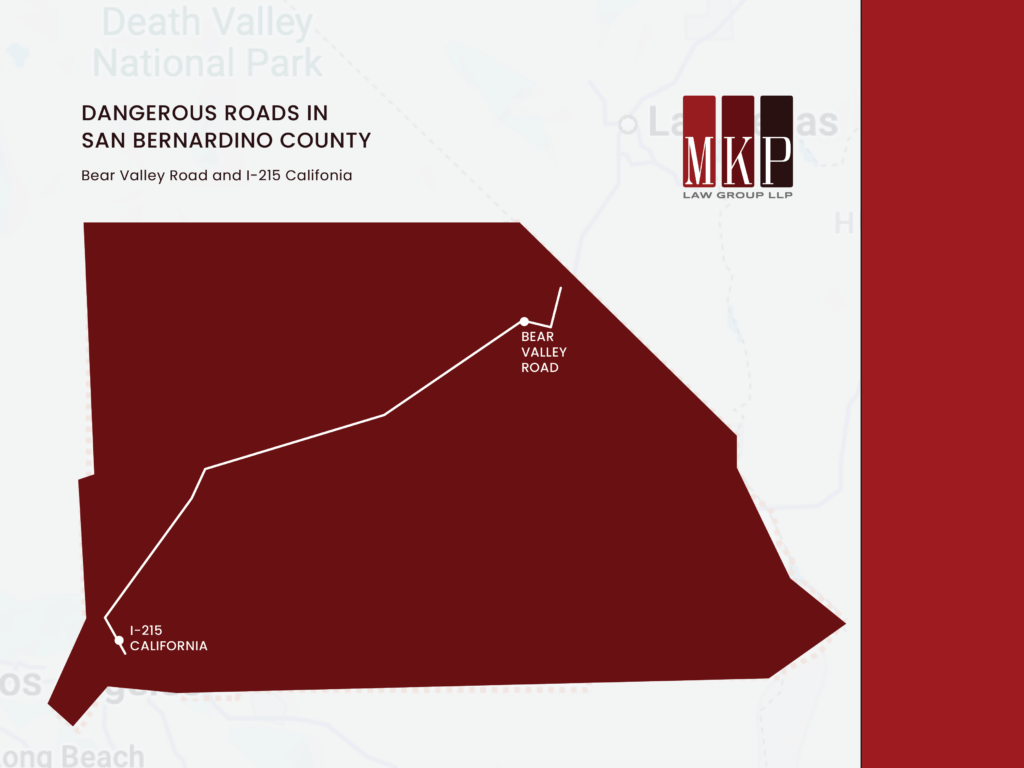
- Bear Valley Road: This heavily trafficked road has a high incidence of fatal accidents due to speeding and poor road conditions.
- Interstate 215 (I-215): Known for frequent collisions due to high traffic volumes, lane shifts, potholes, and aggressive driving behaviors.
Dangerous Roads in San Diego County
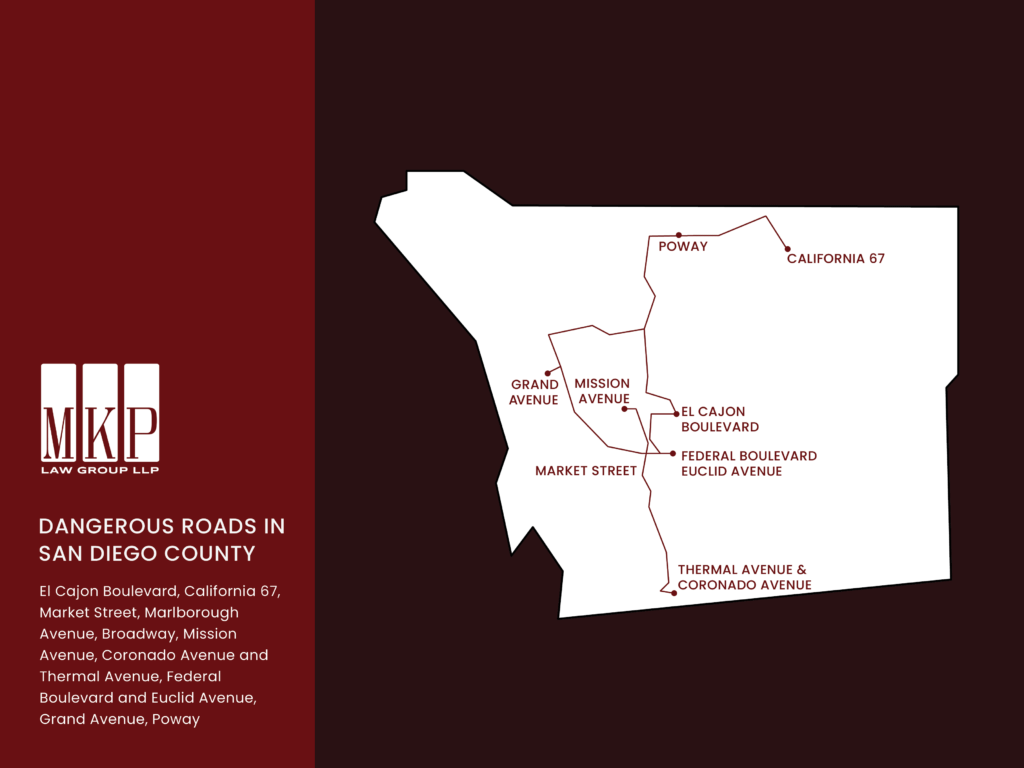
- El Cajon Boulevard: A major urban road with high pedestrian traffic and frequent accidents. Speeding and dim lighting contribute to accidents on this road.
- California 67 (SR-67): A rural highway notorious for high-speed crashes and fatal head-on collisions, and was commonly known as “Slaughterhouse Alley” due to the high number of accident fatalities.
- Market Street: Known for its dangerous intersections and frequent vehicle-pedestrian accidents.
- University and Marlborough Avenue: A problematic intersection with frequent reports of collisions due to pedestrian traffic and intersection design.
- Broadway: This busy street has high accident rates due to high speeds and frequent stops.
- Mission Avenue: Frequent accidents occur here due to inadequate traffic control measures and high congestion levels.
- Coronado Avenue and Thermal Avenue: A dangerous intersection with poor visibility and a high incidence of side-impact crashes.
- Federal Boulevard and Euclid Avenue: A high-risk intersection with frequent collisions involving vehicles and pedestrians.
- Grand Avenue: Known for aggressive driving and frequent accidents, including accidents involving pedestrians, especially during rush hour.
- Scripps Poway Parkway: A dangerous stretch of road with sharp curves and many rollover accidents.
What Is the Most Dangerous Part of the Roadways in Southern California?
While highways and major roads pose significant risks, intersections remain some of the most hazardous locations. Poor visibility, heavy traffic flow, and reckless driving contribute to numerous accidents at these junctures. Many accidents occur due to red-light running, failure to yield, and distracted driving. Pedestrian and cyclist involvement is also a significant concern, particularly in urban areas where foot traffic is high.
Studies have shown that intersections with complex traffic patterns, multiple turning lanes, and high-speed merging lanes increase accident risks. Areas with outdated traffic signals, inadequate signage, or obstructed sightlines are dangerous.
Some of the most dangerous intersections in Southern California include:
- Devonshire Street & Reseda Boulevard (Los Angeles): High traffic volume and signal timing issues create hazardous conditions for vehicles and pedestrians.
- Manchester Avenue & Avalon Boulevard (Los Angeles): A high-speed intersection with frequent pedestrian crossings, leading to increased accident risks.
- Bristol Street & Campus Drive (Newport Beach): A busy junction with heavy commuter and retail traffic, often leading to side-impact collisions.
- Federal Boulevard & Euclid Avenue (San Diego): Known for poor visibility, sudden lane changes, and a high frequency of pedestrian-related accidents.
Authorities have identified these intersections for potential safety improvements, including better signage, enhanced lighting, pedestrian overpasses, and stricter traffic law enforcement.
Which Is Usually the Most Dangerous Hazard on the Road?
More than poor road design or environmental conditions, the most dangerous hazard on the road is other drivers. Reckless behavior, including speeding, distracted driving, aggressive driving, drowsy driving, and impaired driving, significantly increases the likelihood of accidents. Other common hazards include:
- Poor weather conditions (rain, fog, high winds)
- Debris on the road (rocks, fallen trees, tire remnants)
- Animal crossings (especially in rural and mountainous areas)
- Road construction zones (uneven pavement, sudden lane shifts)
- Mechanical failures (brake failures, tire blowouts)
How Can Safety Be Improved on Southern California Roadways?
Improving road safety in Southern California requires a comprehensive strategy that addresses multiple factors contributing to hazardous conditions.
- Road Maintenance: One essential approach is better road maintenance, which includes repairing potholes, ensuring clear and visible signage, and maintaining lane markings. Well-maintained roads help prevent accidents by reducing unexpected hazards for drivers.
- Strict Traffic Law Enforcement: Authorities must actively and consistently target reckless behaviors such as speeding, aggressive driving, and driving under the influence of drugs or alcohol. Increased patrols and traffic cameras in high-risk areas can deter dangerous driving and improve compliance with road safety laws.
- Upgrading Infrastructure: Expanding roads to accommodate high traffic volumes, adding additional traffic signals at key intersections, and installing roundabouts in accident-prone areas can improve traffic flow and reduce collision rates. Additionally, better lighting in poorly illuminated areas can enhance visibility for both drivers and pedestrians.
- Public Awareness Campaigns: Educating motorists about the dangers of distracted driving, the importance of obeying speed limits, and the necessity of safe pedestrian interaction can help foster responsible road behavior. Schools, workplaces, and community organizations can collaborate on safety programs encouraging conscientious driving.
- Pedestrian and Cyclist Protections: Installing more clearly marked crosswalks, building pedestrian bridges where needed, and designating bike lanes can significantly decrease accidents involving non-motorists. Implementing traffic-calming measures in residential neighborhoods, such as speed bumps and curb extensions, can also enhance overall safety for all road users.
How Can MKP Law Group, LLP Help After a Car Accident?
If you or a loved one has been involved in an accident on one of Southern California’s most dangerous roads, MKP Law Group, LLP is here to help. Our Los Angeles car accident lawyers fight aggressively for accident victims, ensuring they receive the compensation they deserve for medical bills, lost wages, and emotional distress.
Our attorneys provide personalized legal support, handling everything from insurance negotiations to litigation when necessary. Do not face this challenging time alone — contact MKP Law Group, LLP today to discuss your case and protect your rights.
